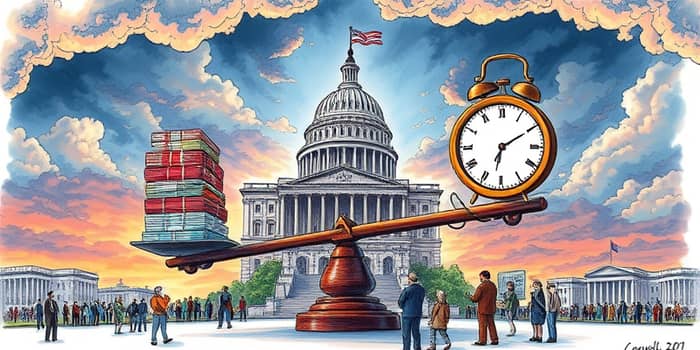
In recent months, negotiations over the debt ceiling have injected waves of uncertainty into global bond markets. The limit, reinstated at $36.1 trillion on January 2, 2025, has driven investors and policymakers to brace for potential fallout. While disagreements in Congress may seem distant from daily finance, the stakes are high. Treasury yields can spike, credit ratings may suffer, and borrowing costs can rise. Understanding these dynamics and adopting practical strategies is critical. This article offers context, historical lessons, and actionable steps to help individuals and institutions remain resilient during fiscal showdowns.
The debt ceiling is a statutory cap on the total amount the federal government can borrow to cover obligations already approved by Congress. It does not authorize new expenditures but limits the capacity to honor existing commitments. When the ceiling binds, the Treasury employs accounting and cash management tactics—measures designed to temporarily free up cash. While such measures can avert immediate default, they do not solve underlying budget tensions.
Only the United States and Denmark impose fixed cash limits, though Denmark’s ceiling is so high it never creates crises. Most nations track debt relative to GDP, offering more flexibility. In the U.S., a failure to raise the cap risks missed payments on Social Security, Medicare, or bond interest—an outcome that could shake confidence in the American economy.
Past debt ceiling episodes offer sobering lessons. In 2011, a protracted standoff led to a U.S. credit rating downgrade by S&P—the first in history—and an extra $1.3 billion in borrowing costs that fiscal year. Over the following decade, higher risk premiums added roughly $18.9 billion in interest payments. In 2013, uncertainty triggered short-term Treasury bill yield spikes and an 800-point drop in the Dow Jones Industrial Average over three weeks. Even the near-brush in 2023 rattled markets, reminding investors that political brinkmanship carries real costs.
With Treasury Secretary warnings that the government may exhaust extraordinary measures by August 2025, traders and institutions are closely monitoring cash flows. A default, even temporary, would be unprecedented in scale and globally disruptive.
When debt ceiling debates intensify, bond markets can become a minefield. Yet investors can protect portfolios by embracing diversified approaches. No single tactic eliminates risk, but a combination of methods can buffer shocks and preserve capital. Below are key strategies to consider:
Diversification reduces concentration risk, ensuring that a sell-off in Treasuries does not derail overall returns. Laddering bonds—purchasing securities with staggered maturities—helps manage reinvestment risk and maintain access to cash. A dedicated cash reserve enables investors to seize opportunities or meet obligations without forced selling at unfavorable prices.
Civic participation plays a vital role in shaping fiscal policy. While markets adjust, policymakers negotiate terms that balance spending priorities and debt sustainability. Constituents can engage constructively by contacting representatives, attending town halls, or supporting organizations focused on long-term fiscal sustainability and market confidence. Clear, respectful dialogue helps bridge divides and encourages solutions that safeguard economic health.
Understanding the viewpoints of both parties can foster compromise. Some lawmakers advocate spending cuts paired with ceiling increases, while others push for parallel revenue adjustments. By amplifying voices that favor responsible budgeting without risking default, individuals contribute to a climate where pragmatic policies can emerge.
The so-called X-date—when the Treasury may no longer meet obligations—remains fluid but is projected for late summer 2025. To navigate this critical window, organizations and individuals should follow a practical checklist:
Liquidity stress tests are especially important for corporations and municipal entities that rely on short-term funding. By simulating scenarios where Treasury yields surge, stakeholders can identify vulnerabilities and strengthen financial resilience prior to any market disruptions.
As debates over the debt ceiling unfold, the global economy watches with bated breath. Treasury securities remain the backbone of the international financial system, and the U.S. dollar’s status as the reserve currency hinges on trust in American fiscal management. While political wrangling can appear adversarial, informed engagement and prudent strategies allow markets and citizens to weather uncertainty.
Ultimately, navigating debt ceiling risks demands a blend of vigilance, diversified investments, and civic advocacy. By staying informed, preparing for volatility, and promoting fiscal responsibility with balanced policy, individuals and institutions can help ensure that future negotiations bolster economic stability rather than threaten it. In these pivotal times, knowledge and proactive planning are the most powerful tools at our disposal.
References













